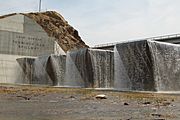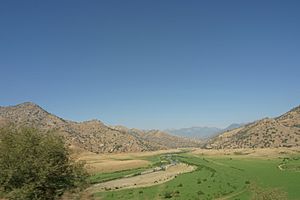Terminus Dam facts for kids
Quick facts for kids Terminus Dam |
|
|---|---|

The dam and Lake Kaweah as seen from the visitor center along Route 198
|
|
| Location | Three Rivers, Tulare County, California, United States |
| Coordinates | 36°25′01″N 119°00′14″W / 36.41694°N 119.00389°W |
| Opening date | 1962 |
| Construction cost | $24 million |
| Owner(s) | |
| Dam and spillways | |
| Type of dam | Earthfill |
| Impounds | Kaweah River |
| Height | 255 ft (78 m) |
| Length | 2,375 ft (724 m) |
| Elevation at crest | 750 ft (230 m) |
| Dam volume | 7,000,000 cu yd (5,400,000 m3) |
| Reservoir | |
| Creates | Lake Kaweah |
| Total capacity | 185,600 acre⋅ft (0.2289 km3) |
| Catchment area | 561 sq mi (1,450 km2) |
| Surface area | 1,945 acres (787 ha) |
| Power station | |
| Commission date | 1992 |
| Installed capacity | 20.09 MW |
| Annual generation | 40,894,000 KWh (2001–2012) |
| Website U.S. Army Corps of Engineers - Lake Kaweah / Terminus Dam |
|
Terminus Dam is a dam on the Kaweah River in Tulare County, California in the United States, located near Three Rivers about 15 mi (24 km) from the western boundary of Sequoia National Park and 20 mi (32 km) east of Visalia. The dam forms Lake Kaweah for flood control and irrigation water supply. Completed by the U.S. Army Corps of Engineers (USACE) in 1962, Terminus is an earthfill dam 255 ft (78 m) high and 2,375 ft (724 m) long. The reservoir has a maximum capacity of 185,600 acre⋅ft (0.2289 km3) of water, although it usually sits at much lower levels.
History
Terminus Dam is one of four dams built on the rivers of the Tulare Lake basin, located at the southern end of the San Joaquin Valley. In the 1920s, the USACE and the State of California first surveyed the area for suitable reservoir sites to provide irrigation water. After devastating floods in the late 1930s, the Flood Control Act of 1944 authorized the USACE to build Terminus Dam as part of a system to provide flood protection for the Tulare basin.
In 1948, with plans for the dam on the Kaweah River nearly complete, an archaeological survey of the future reservoir site revealed an unusually rich selection of Native American artifacts. Many of these were removed by the U.S. National Park Service's Interagency Archaeological Salvage Program before the beginning of work on the dam.
Construction of Terminus Dam started in the late 1950s and was completed in 1962. The dam was dedicated along with the Success Dam, further south on the Tule River, on May 18, 1962. The reservoir filled for the first time in 1964 to its initial capacity of 150,000 acre⋅ft (0.19 km3). Sedimentation had reduced this to 143,200 acre⋅ft (0.1766 km3) according to a study conducted in 1977.
Together with the three other major dams in the Tulare basin, Terminus Dam contributed to the desiccation of Tulare Lake, once one of the largest wetland regions in the United States.
Spillway expansion
In the 1990s the USACE began studies for a project to increase the capacity of the dam's spillway, which was considered inadequate to pass the probable maximum flood on the Kaweah River. In 2001 work began to enlarge the spillway channel and between 2003 and 2004 six fusegates were installed in the spillway channel, raising the maximum elevation of the reservoir by 21 ft (6.4 m). The fusegates, invented and patented by François Lempérière for Hydroplus, subsidiary of GTM Entrepose, are the largest in the world, and are designed to open automatically by water pressure when Lake Kaweah reaches dangerously high levels. The design was chosen because it would provide cost savings over conventional options such as a concrete or gated spillway.
The project increased the storage capacity of Lake Kaweah by more than 40,000 acre⋅ft (0.049 km3), to its current capacity of 185,600 acre⋅ft (0.2289 km3), and ensured the capability of Terminus Dam to pass a flood of up to 300,000 cu ft/s (8,500 m3/s). The dam is now capable of completely controlling a 70-year flood, as compared to a 46-year flood before the fusegates were installed.
Functions
Terminus Dam's primary purpose is flood control; consequently, the reservoir is usually maintained at a very low level, except in late spring and early summer when it is used to store snowmelt runoff from the Sierra Nevada. The dam provides flood protection for 500,000 acres (2,000 km2) of farmland and 300,000 people along the lower Kaweah River. Shortly after its completion, the dam and reservoir were put to the test by record floods in December 1966, during which Terminus, Success and Isabella Dams prevented a collective $81.9 million of damages. Between 1962 and 2012, Terminus Dam has prevented $373,225,000 of flood-related damages.
Water releases from Terminus Dam are made based on agricultural demand when flood control releases are not required. Snowmelt runoff stored in Lake Kaweah are released at high rates between May and late July-early August during the peak of the irrigation season. The water serves multiple local water districts such as the Tulare Irrigation District (TID) and Kaweah Delta Water Conservation District (KDWCD), as well as urban areas including Visalia and Tulare. The dam also generates hydroelectricity from a plant built in 1992 by the Kaweah River Power Authority (KRPA), which is jointly managed by TID and KDWCD. Electricity generated here is distributed by Southern California Edison. The power plant currently has a capacity of 20.09 megawatts (MW), upgraded from its original capacity of 17 MW, and generates roughly 40 million kilowatt hours (KWh) per year. The KRPA plans to expand this capacity by a further 9 MW, which would allow for the generation of an additional 9.2 million KWh.



